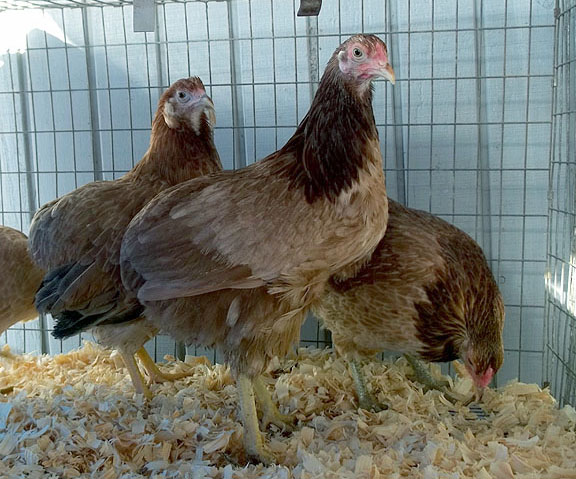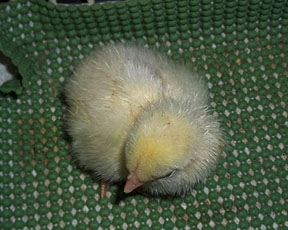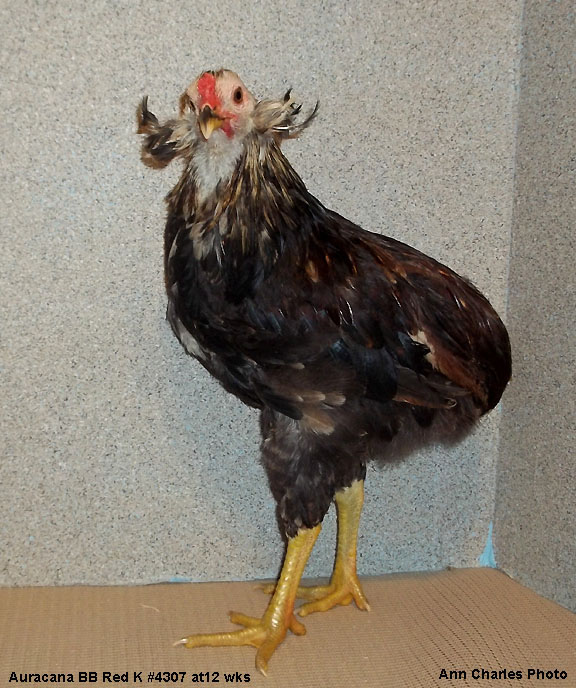
Pictured
is 'Will Wheaten' #171 (my husband named him) and it is not a great
photo. He is molting, underweight, and just a bit miserable, but you
can get an ideal of his color in comparison to the written APA
standard. This guy was the sire of the majority of my good BB
Red Araucana chicks that I will be showing in the Spring of
2013. He was an outstanding sire. See pix of a couple of
his young sons below.
Brian Reeder's
genotype for the APA BB Red Araucana is :
eWh/eWh s+/s+ Ap/Ap
Mh/Mh Ml/Ml (see pages 3, 9-10,14, 20,21, 36, 50 of his book "An
Introduction To Color Forms Of The Domestic Fowl . . .".
The APA description
of the Black Breasted Red Araucana can be found on page 199 of the
2010 APA
Standard of Perfection. With a description
of the color being the same as the BB Red Cubalaya found on page 188
of the same book (and a color illustration on page 207) . . .Male:
head, neck, and hackle, "Reddish Chestnut . . . gradually
shading to bright golden at lower part "(of hackle). This
would be the IDEAL hackle color for the BB Red Araucana male
bird. To achieve it, all genes as show above, would probably
have to be homozygous.

Pictured
above are 3 Black
Breasted Red Araucana pullets. The two toward the right are
currently in my wheaten breeding pen. Notice their coloration
is like a BB Red Cubalaya instead of the wild type (e+) BB Red hen
that you would see in the Light Brown Leghorn or the ABA bantam form
of Araucana.
 
To the left, typical
solid yellow BB Red Araucana chick down (newly hatched). Photo
to the right: 2 week-old Araucana chick with typical BB Red juvenile
feather growing in on wings.

8 week old BB Red Araucana Cockerel sired
by "Will" (at top of page).
7 week old BB Red Araucana Cockerel sired
by "Will" (at top of page).
I would like to make
the following observations about
my 'dark red wheatens' (APA BB Red) . . . 1)
This is one of the rarest
colors to find in the Araucana. 2)
It is an approved APA variety
(not an AOV) which means these birds are eligible to compete not
only for Best of Variety and Best of Breed, but also Champion AOSB,
and upwards. 3)
My dark red wheatens are usually
excellent type birds with size, good wing carriage, and nice combs.
4)After many years of selective
breeding and stringent culling I am getting approx. 50% chicks with
double tufts (which is RARE in the world of Araucana). If you use
one of my wheaten cockerels or pullets on any other color in your flock they
will be improving your tufting genetics substantially. And good
tufting is the most complex of all the Araucana traits to breed for.
New Photos ~ 11/24/2012

 Sold
Sold to Diana
Engelbart, West Bolyston, MA. (11/25/2012) Good luck with her at the
Congress in 2013! Sold
Sold to Diana
Engelbart, West Bolyston, MA. (11/25/2012) Good luck with her at the
Congress in 2013!

|
Genetically,
the Araucana should be the 'dark red wheaten' (Ewh) based version of BB Red.
Per the 2012 APA
Standard Of Perfection, the Black Breasted Red Araucana should be
the same color as described for the Black Breasted Red Cubalaya, in
both large fowl & bantam.
The primary color
differences between the various types of BB Red in the general
chicken population will be with the hen's coloration. There
are only minor differences between the BB Red coloration of the male
Black Breasted Red birds.
APA Recognizes five
varieties of Araucana: Black, White, BB Red, Silver Duckwing and
Golden Duckwing. The wild type BB Red hens, although not
correctly colored for showing as an APA BB Red are still useful as
breeders if you are working on Golden and Silver Duckwing since both
are 'e+' based colors.
---------------------------
Pertinent quotes from
Brian Reeder's Book on the specific genes in the "Dark Red
Wheaten" genotype.
eWh (Wheaten):
"It
seems to be an extension of pheomelanin and a reduction of eumelanin,
especially in the female. . . .The chick down of Ewh tends to be
solid white or yellow . . ."
S (Sex Linked Silver): "S
is a dominant allelle, whose alternate is s+ (red/orange/gold
- wild type)".
Ap (Autosomal Pheolmelanin):
"This form of
pheomelanin is not on the s-allele and is not effected by
Silver" (S) . . .Ap is a dominant gene . . .with incomplete
dominance in the heterozygous state (Ap/ap+)"
Mh (Mahogany):
"This
gene intensifies red, turning it to a deep dark blood red . .
."
Ml (Melantoic): Ml is
an autosomal dominant and shows variable penetration in the
homozygous state . . .Ml has the strongest effect on the hackle
featheringing in both sexes on the top of the head . . .ML does not
seem to be very effective in eumelanizing the lower hackles."
--------------------------
"The dark black
breasted red is a dark wheaten and is found in the very old Asiatic
Games . . .and the . . . Cubalaya which traces back to
this breeds. It is theorized that the dark black breasted red is
the basic phenotype of recessive wheaten", Page
178, Bantam Chickens, Fred P. Jeffreys.
"Wheaten also becomes
"recessive" in the presence of eumelanizers to both e+ and
eb, while in the absence of eumelanizers it is dominant to
these alleles. . .In many instances, eWh makes a lighter underfluff on
adult birds, but tis is not a hard and fast rule, as eumelanization
can produce darker underfluff on this allele. Page
36, "Color Forms . . ." by Brian Reeder
|